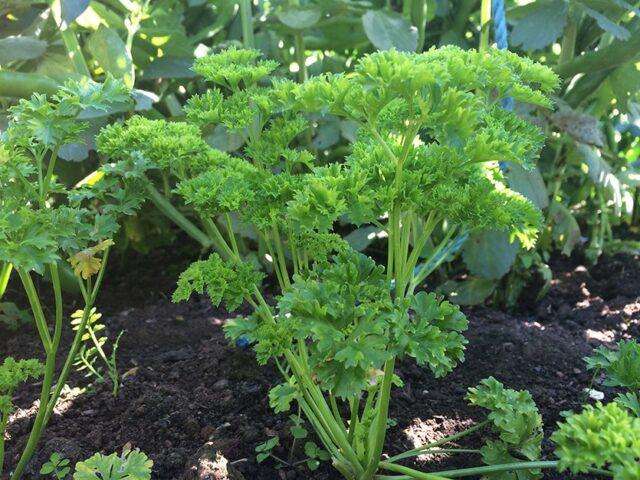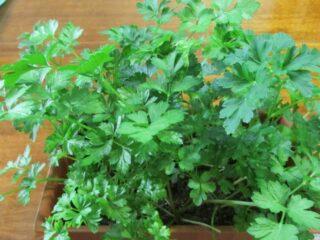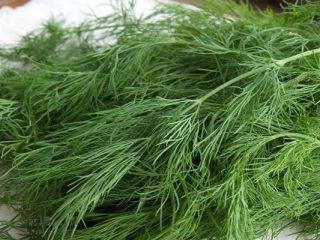Content
- 1 When can you sow parsley in open ground in spring?
- 2 After what crops can parsley be planted?
- 3 Choosing a place to plant parsley
- 4 Soil preparation
- 5 Seed selection and preparation
- 6 Depth and pattern of planting parsley seeds in open ground in spring
- 7 Caring for parsley in open ground
- 8 Collection and storage
- 9 Possible mistakes
- 10 Conclusion
Parsley is an unpretentious, frost-resistant garden plant, the foliage and roots of which are used in cooking. Thanks to greens, dishes acquire a unique taste and bright aroma. To have the spice on the table all year round, you should know not only how to properly plant parsley in the spring and care for it, but also collect it in a timely manner.
When can you sow parsley in open ground in spring?
To obtain greenery throughout the season, parsley is planted several times at intervals of one and a half months. When sowing in spring, they focus on warming up the soil and the average daily air temperature. They should not be below +3 ⁰С. The seeds are able to withstand cold temperatures and even short-term frosts.Most often, parsley sowing begins in April, if necessary, shifting the dates to earlier or later, depending on the climatic and weather conditions of the region.

In the first year after planting, the plant forms a rosette, in the second year it blooms and produces seeds.
When to plant parsley in open ground, depending on the region
After warm weather sets in, begin planting parsley. In the southern regions, where spring comes early, this time coincides with the beginning of March. In the middle zone and the Far East, sowing is carried out in the second or third ten days of April, in the Leningrad region - one to two weeks later, in Siberia and the Urals - until mid-May. If the agricultural techniques for growing parsley are followed, the first greens are obtained two months after planting.
Favorable days for planting parsley according to the lunar calendar
Many gardeners adhere to the lunar calendar in their work. Every day has its own energy, carries both positive and negative energy. Based on the calendar, you can plan your work correctly, choose the most favorable time for planting in the spring and avoid bad days.
The length of the lunar month is 29.5 days, during which the Earth's satellite makes a full revolution around it. The moon goes through four phases: new moon, first quarter, full moon and last quarter.
It is believed that the new moon is the worst period for gardening work, including planting greenery in the spring. You should refrain from performing them for three days - on the new moon, the day before and after it.
On the waxing Moon, all crops that ripen above the soil surface develop well.These include parsley, which, when grown in open ground from seeds in the spring, promises a rich harvest. During the full moon, it is better to take care of it - weeding, watering, loosening. The waning moon gives energy to root crops located underground, so this period is suitable for planting root parsley.
The zodiac sign also influences the development of plants in spring. Garden herbs grow successfully when the waxing Moon is in Capricorn, Pisces, Aries, Virgo, Taurus, Libra or Scorpio.

Astrologers believe that the spicy culture is influenced by two planets - Pluto and Mercury
After what crops can parsley be planted?
When planting greens in the spring, it is very important to observe crop rotation. Alternation of crops allows you to maintain high and regular yields, avoid soil depletion, the emergence of diseases and pests.
Neutral precursors include cabbage, radish, radish, daikon and other cruciferous vegetables. Cumin belongs to the same family as parsley, but their diseases and pests are different, so the plant is quite suitable for planting. Legumes are recommended for use as green manure. Lupine, vetch, alfalfa, clover, plowed into the soil, enrich it with nitrogen.
Cucumber, pumpkin, and zucchini are the best predecessors, since their roots perfectly structure the soil. Onions, garlic, and mustard help destroy parsley pests, so they can also be planted before it. It is permissible to plant greens after nightshades - potatoes, tomatoes. They have different pests and “food interests”, so they do not infringe on each other.
Choosing a place to plant parsley
The quality of foliage and the speed of its growth are greatly influenced by the growing conditions of parsley.Despite the unpretentiousness of the culture, you should choose a well-lit place or light partial shade. It is unacceptable to use areas subject to flooding in spring and summer. Spice does not like drafts and cold winds. The soil should have moderate moisture, looseness and fertility.
Planting in a waterlogged area often leads to foliage damage from powdery mildew, rust, and damage from aphids and slugs.
To get greens as early as possible, parsley is planted in the spring on the south side of the slopes, first adding organic matter.

Slightly acidic or neutral soil is suitable for growing parsley.
Soil preparation
Preparing the area for planting parsley in the spring begins in the fall. They operate according to the following scheme:
- Predecessor plants, debris and weeds are removed.
- Organic fertilizers are applied (4 kg per square meter).
- Dig to a depth of 25 cm.
- In the spring, superphosphate, potassium chloride and saltpeter are added.
- Loosen the soil.
- They make ridges.
- Cover with film.
The structure of clay soil will improve significantly if you add sand to it. High acidity is neutralized with wood ash, lime and dolomite flour.
Seed selection and preparation
It is impossible to properly plant parsley in open ground in the spring unless the seeds are fully prepared. First, they are calibrated and low-quality specimens are removed. For this purpose, the seed material is dipped into a saline solution (10 g of salt per 300 ml of water) and only those that have settled to the bottom are selected. Wash and immerse in warm water for 24 hours to remove the oil film. Then the parsley seeds are transferred to a solution of a growth stimulator (Epin, Zircon, Heteroauxin).To speed up germination in the spring, you can subject them to vernalization (place in a damp cloth) and bubbling (saturation with oxygen in a reservoir of water).

To remove the film before planting in the spring, seeds are soaked in vodka or diluted alcohol.
Depth and pattern of planting parsley seeds in open ground in spring
To quickly get friendly shoots, you need to fulfill several conditions for planting parsley:
- Make grooves in the soil of the ridges at a distance of 20 cm from each other.
- The depth should be 2 cm for early planting and 1 cm for late planting.
- Sprinkle them generously with warm water an hour before sowing.
- Place the seeds at 1 cm intervals.
- Fall asleep.
- Lightly compact the soil.
- Cover the bed with non-woven material or film.
Germination depends on the temperature and humidity of the soil, and the quality of the seeds. On average, in the spring this takes from one to two weeks.
Caring for parsley in open ground
Despite the fact that growing greens is not particularly difficult, it is necessary not only to plant parsley seeds correctly in the spring, but also to carefully care for the seedlings. All operations are not complicated, they do not require much time and effort, and the return on them is high.
Watering and loosening
After germination in the spring, it is necessary to ensure that the soil remains clear of weeds. While the parsley is small, they are removed manually from the rows and in the rows themselves. This is easier to do after moistening, since the earth softens and becomes less dense. As soon as the greenery grows, the rows are loosened after each rain and watering. As a result, the earth crust is destroyed, and oxygen penetrates into the soil to the roots in sufficient quantities.
Plantings are watered regularly in spring and summer, keeping the soil moist. For this purpose, warm, settled water is used.

Overmoistening of the soil in spring can provoke fungal and viral infections
Top dressing
When growing parsley, you can get by with environmentally friendly organic fertilizer. Humus or rotted manure is applied to the soil for autumn or spring digging, using up to 8 kg of organic matter per square meter. For root varieties, peat, sawdust and compost are used. After the second pair of leaves appears, the greens are watered with herbal infusion. To prepare it, the weeds are placed in a container and filled with water. After a week and a half, dilute it 10 times and feed the seedlings.
When using mineral fertilizers when growing parsley in the spring, they act according to the following scheme:
- In the fall, when digging, add 30 g of superphosphate and 20 g of potassium salt per square meter to the soil.
- In spring, seedlings are watered with a solution of ammonium nitrate (10 g) and superphosphate (5 g) per 10 liters of water.

To feed parsley in spring, complex mineral fertilizers are used together with organic fertilizers.
Protection from diseases and pests
Parsley diseases are signaled by external signs that appear on the foliage after planting. Maximum attention should be paid to the health of plants if discoloration, spots, or wilting of greenery are noticeable. Pathologies and pests can not only reduce the quality of the leaf mass, but also completely destroy parsley.
White rot
The disease affects root varieties. Root vegetables become soft and gradually rot.Treatment of parsley with Bordeaux mixture, disinfection of seeds before planting, and crop rotation are used as control and prevention.
Rust
The main sign of pathology is the appearance of brown spots on the foliage. It gradually fades and dries up. You can get rid of the disease at an early stage, in the spring, if you spray the parsley with Bordeaux mixture (1%), remove the weeds and loosen the soil.
Powdery mildew
A fungal infection affects foliage and stems. A gray coating becomes visible on them, the plants become stiff and crumble. An effective way to combat is treatment with a solution of soda ash, spraying with an infusion of tansy and wood ash.

Powdery mildew often affects parsley growing in greenhouses
If crop rotation is not observed and weather conditions are unfavorable, parsley is threatened by insect pests - carrot fly, melon aphid. To combat them, traditional methods are used - treatment with infusion of horseradish leaves, dandelions, wormwood or insecticides.
Collection and storage
You can use parsley for culinary purposes at any stage of its development, but it is most convenient to do this a month and a half after planting. Select branches growing from the outside and cut them at the root, which stimulates the appearance of new ones.
The spices are prepared in warm, dry weather. The shoots are wrapped in a damp cloth and placed on the middle shelf of the refrigerator. Fresh greens can be stored for a week if a bunch is placed in a glass of water.
To prepare for the winter, parsley foliage is dried or frozen.In the first case, the spice is placed on a clean cloth in a shaded place with good ventilation or an electric dryer is used, which will significantly reduce the operation time. You can freeze parsley whole by pre-packing the bunches into bags and putting them in the freezer. Another option is to place the chopped greens in a cube mold, add water and turn the mixture into ice. Use the product in winter, defrosting as needed.
Root parsley is dug up in the fall, before the onset of frost, and stored until spring in a cellar, basement or refrigerator at a temperature of +2 ⁰C and a humidity of 85%.

Dry parsley is stored in a glass container in a dark place.
Possible mistakes
When planted correctly in spring, parsley seedlings appear in open ground two to three weeks after sowing with dry seeds. Vernalized specimens speed up the process by half. If after a month there are no green sprouts, then mistakes were made in agricultural technology. The most common among them:
- Poor quality, unripe seeds.
- Parsley seed has expired (more than two years).
- Insufficiently warmed soil.
- Dry soil.
- A hard earthen crust formed after rain.
- Unfavorable weather, prolonged recurrent frosts.
To solve the problem, use a growth stimulator, in which the seeds are soaked before planting in the spring or used after and during watering. By covering parsley crops with spunbond or lutrasil, you can reduce the time it takes for greenery to emerge by maintaining a higher soil temperature. To prevent weeds from drowning out the plants, it is necessary to fight them, removing them along with the roots.After weeding, the soil is loosened, mulched with pine needles, compost and fallen leaves. Instead, you can use black film, which does not allow weeds to develop in the planting.
Conclusion
Experienced gardeners begin to plant parsley in the spring as one of the first among vegetables. It is unpretentious, easily tolerates weather surprises, and grows quickly after germination. With proper care, there is enough spice not only for use in summer, but also for winter.








